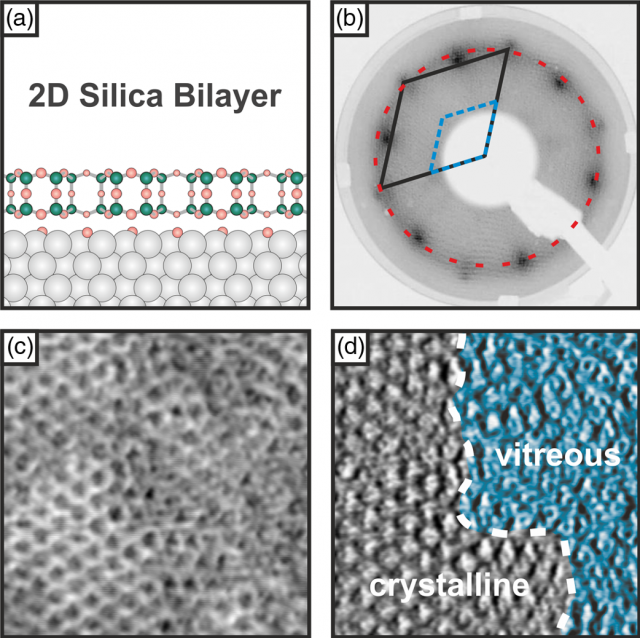The flexibility of 2D silica
Since the discovery that graphene, the two dimensional carbon allotrope, can be isolated and incorporated into electronic devices intense research efforts have been triggered. Driving forces usually mentioned behind the experimental and theoretical studies of graphene are the exceptional electronic properties, in particular the high electron mobilities, the long spin coherence lengths and the possibility to access exciting physical effects such as the integer quantum Hall effect or Klein tunneling.
Still, there is something more to graphene that those outstanding electronic properties, and it is purely mechanical: graphene is flexible, a big advantage for a range of applications, starting with flexible electronics.
But graphene alone would not be sufficient for flexible electronics, as both conductive and insulating layers are needed. Actually, several free-standing 2D materials, transferable and stable under various conditions, would be necessary in order to tune properties such as the band gap, thermal conductivity, and resistivity through strain engineering.
In order to find suitable flexible materials we need to measure this property in them. One way of measuring how flexible something is is doing just the opposite, measuring how rigid it is. A variable that it is useful for this purpose is the bending rigidity, κ, also known as flexural bending rigidity, flexural rigidity, bending modulus, or bending stiffness. It is measured in joules but values for 2D materials are customarily expressed in eV.
Even though several experiments exist on the measurement of elastic moduli for 2D materials, single and few-layer graphene are the only 2D materials where the bending rigidity has been measured directly.

Now, a team of researchers, including Joseph R. Manson, from Clemson University and DIPC, has measured 1a chemically stable bilayer of 2D silica (SiO2), a new, wide band gap 2D material. This measurement represents the the first direct one of the bending rigidity on a non-monoatomic 2D material.
In 2015 Al Taleb et al. introduced 2 a new technique for measuring the bending rigidity of 2D materials: inelastic helium atom scattering (HAS). Using a recent theoretical approach Al Taleb et al. obtained a bending rigidity of copper-supported single layer graphene of κ = 1.30 eV ± 0.15 eV, the first experimental value in agreement with theoretical calculations. The value is extracted from the flexural bending mode in the phonon spectrum.
Silica is one of the most abu ndant materials on earth and the basis of a large class of glasses. It is relevant in modern technologies like semiconductor devices, optical fibers, and supports in industrial catalysis. Recently, 2D silica has garnered interest as a model glass for supporting catalytic systems, and as a promising 2D insulator layer. Crystalline and vitreous 2D silica films have been presented.
The researchers use now inelastic HAS to characterize the low-energy phonon modes of an Ru(0001)-supported mixed crystalline and vitreous 2D silica sample. The sample was prepared at the Fritz Haber Institute in Berlin and the HAS experiments were carried out in MAGIE, the molecular beam apparatus at the University of Bergen.
From these measurements the bending rigidity is extracted. The researchers find a value of κ = 8.8 eV ± 0.5 eV which is of the same order of magnitude as theoretical values in the literature for freestanding crystalline 2D silica. This is only about 4 times stiffer than single-layer graphene. It could turn out to be very useful to have a microscopically thin layer of an insulator which is also demonstrably quite flexible.
Author: César Tomé López is a science writer and the editor of Mapping Ignorance.
References
- C. Büchner, S. D. Eder, T. Nesse, D. Kuhness, P. Schlexer, G. Pacchioni, J. R. Manson, M. Heyde, B. Holst, and H.-J. Freund (2018) Bending Rigidity of 2D Silica Phys. Rev. Lett. doi: 10.1103/PhysRevLett.120.226101 ↩
- A. Al Taleb, H. K. Yu, G. Anemone, D. Farías, and A. M. Wodtke, Carbon 95, 731 (2015). ↩